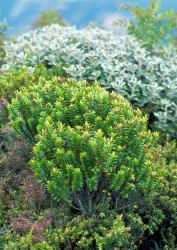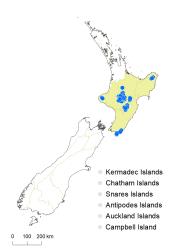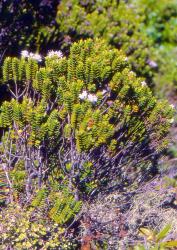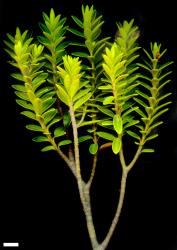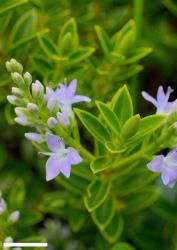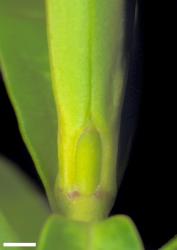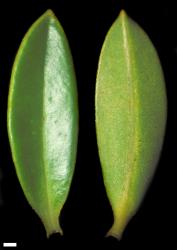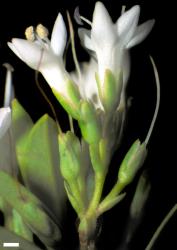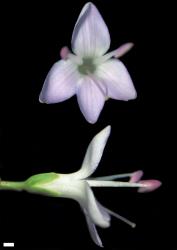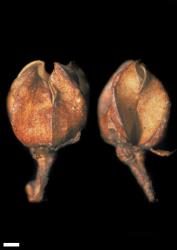- ≡ Hebe venustula (Colenso) L.B.Moore in Allan, Fl. New Zealand 1, 897 (1961)
- = Veronica laevis Benth. in de Candolle, Prodr. 10 461 (1846) nom. illeg., non Veronica laevis Lam. 1778
- ≡ Hebe laevis (Benth.) Cockayne & Allan, Trans. New Zealand Inst. 57: 26 (1926)
- = Veronica azurea Colenso, Trans. & Proc. New Zealand Inst. 31: 277 (1899) nom. illeg., non Veronica azurea Link 1821 – as azunea
Bushy and often rounded shrub to 1.8 m tall. Stems erect, eglandular-pubescent; hairs bifarious; occasionally uniform, minute eglandular hairs also present. Leaf bud distinct, its leaves appressed at margins until fully grown; sinus narrow, acute. Leaves opposite-decussate to weakly sub-distichous, erecto-patent to spreading; lamina coriaceous to rigid, obovate to elliptic, 4–29 mm long, 3–10 mm wide, glossy green to dark green above, paler and duller beneath; midrib evident; surfaces glabrous or rarely with eglandular hairs along midrib above; margin eglandular-ciliolate when young, often with a few glandular cilia, becoming glabrous to minutely papillate with age, entire; apex sub-acute to obtuse, mostly acute, keeled beneath and weakly apiculate; base cuneate; petiole 0.5–6.0 mm long. Inflorescence a lateral raceme or sometimes ternate or rarely a compound raceme, 14–68 mm long; flowers crowded, 7–75, all bisexual; bracts opposite below, becoming alternate above, lanceolate to ovate, ≥ pedicels; pedicels erecto-patent, 0.5–7.0 mm long, eglandular-hairy all around or sometimes almost glabrous. Calyx lobes 4, sub-acute or rarely obtuse, 2–3 mm long, equal or sub-equal, mixed glandular- and eglandular-hairy. Corolla 7–9 mm diameter; tube white, 3.0–4.2 mm long, > calyx, eglandular-hairy inside; lobes 4, white, or purplish when young, erecto-patent to spreading, sub-equal, usually elliptic to ovate, sometimes lanceolate; nectar guides absent. Stamen filaments white or tinged purplish, 3–5 mm long, rarely to 7 mm; anthers magenta to purple. Style glabrous, 6.5–9.0 mm long, rarely to 11.0 mm. Capsules latiseptate, sub-acute, glabrous, 3.5–5.0 mm long, 2.3–3.5 mm at widest point. Seeds ellipsoid to ovoid or oblong, flattened, smooth, brown, 1.3–2.2 mm long.
odora | mooreae | pauciramosa | masoniae | venustula | brachysiphon | |
|---|---|---|---|---|---|---|
Leaf bud sinus | broad, shield-shaped | narrow & acute to broad & shield shaped | broad, shield-shaped | broad, shield-shaped | narrow, acute | narrow, acute |
Leaf margin | sharply bevelled; glabrous | bevelled at 90º to surfaces, glabrous | rounded; glabrous or with minute hairs or denticles | rounded, papillate towards apex; ciliolate when young | weakly bevelled; ciliolate when young, becoming glabrous or papillate | weakly bevelled; ciliolate to ciliate when young, becoming papillate |
Stomata | adaxial – (but often + at Arthur’s Pass); abaxial + | adaxial – (+ at Caswell Sound, Denniston); abaxial + | adaxial +; abaxial + | adaxial +; abaxial + | adaxial ±; abaxial + | adaxial ±; abaxial + |
Midrib | sharply keeled beneath | depressed above; prominent beneath | rounded beneath and flattened just short of apex | keeled throughout | evident but not keeled | evident but not keeled |
Inflorescence | terminal + usually lateral spikes | lateral spikes only | lateral spikes only | terminal spikes only | lateral raceme, sometimes ternate, rarely compound. | lateral raceme, sometimes ternate. |
Bracts | not overtopping calyx | < calyx | < calyx | ≥ calyx | ≥ pedicels, < calyx | ≥ pedicels, < calyx |
Bracts and flowers | opposite | opposite | opposite | opposite | opposite below, becoming alternate | alternate, or lowermost opposite |
Pedicels | 0 mm | 0–1 mm | 0–0.5 mm | 0 mm | 0.5–7.0 mm | 0.6–3.0 mm |
Calyx, anterior lobes | free | free or fused to ⅓-way | fused > ⅔-way | free | free | free |
Corolla lobes | narrow | broad | narrow | broad | ± broad | ± broad |
North Island: Gisborne (Raukūmara Range), Volcanic Plateau, Taranaki (Taranaki National Park), Southern North Island (Ruahine Range and Aorangi Range). Two uncertain records, from Kapiti I. and Mt Holdsworth, are excluded (Bayly & Kellow 2006).
Penalpine and sub-alpine scrub and grassland, at lower altitudes on Aorangi Range. Recorded elevations range from 121 to 1525 m.
V. venustula plants have been reported to hybridise with V. stricta plants, a hybrid known as Veronica ×carsei.
A hybrid between V. venustula and V. tetragona subsp. subsimilis (V. ×laevastonii) has been reported (Garnock-Jones 2008).
Flowers: December–March; fruits: February–April.
2n = 120 (see Bayly & Kellow 2006, as Hebe venustula).
Veronica venustula is classified in V. subg. Pseudoveronica sect. Hebe and the informal group “Apertae” (small-leaved) (Albach & Meudt 2010; Bayly & Kellow 2006). The very close similarity of V. brachysiphon and V. venustula suggests a close relationship. These two are associated with a large group of species that are characterised by mostly green leaves shorter than 40 mm long, and including several others with 2n = 120 (V. evenosa, V. urvilleana) or 2n = 122 (V. topiaria).



